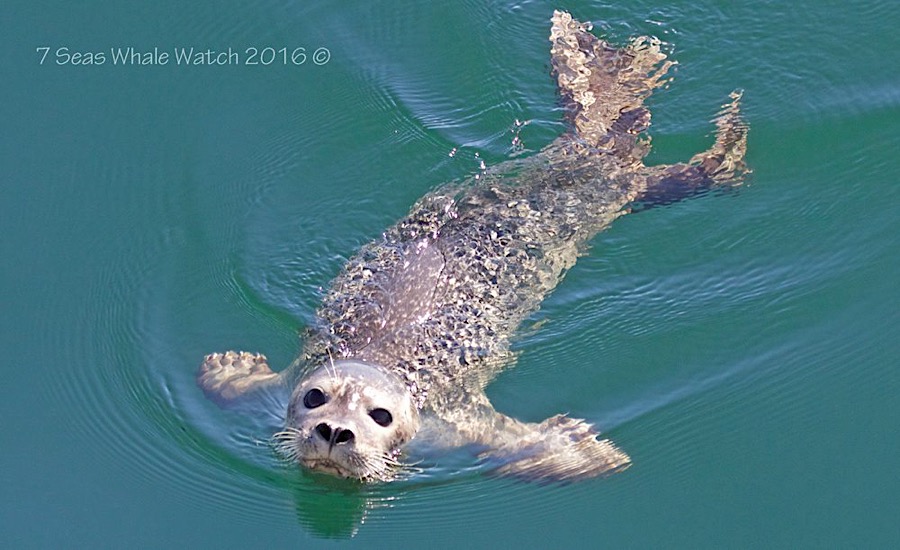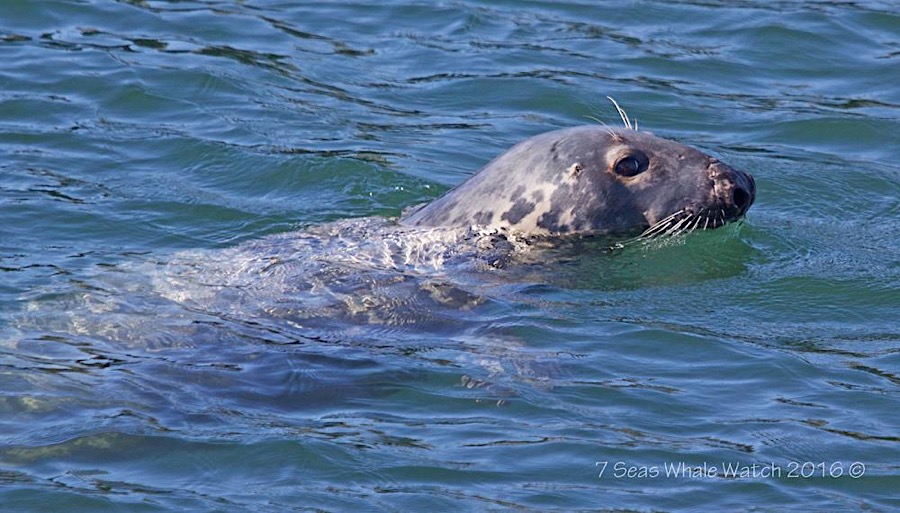Seals
Seals are common in Massachusetts year-round. There are a number of different species that you may encounter while visiting Gloucester, and you can find information on some of the more commonly seen species here.
HARBOR SEAL
Harbor seals are the most common seal species seen on our whale watch trips. They can be found here year-round, although they become more abundant in the Fall and Winter months. They are frequently seen swimming far out to sea or sunning themselves on the rocks in Gloucester harbor (such as those rocks near Stage Fort Park or Dolliver’s neck).
Harbor Seals are medium-sized seals with the males reaching lengths of just over 6 feet and weighing up to 370 pounds. Females are a bit smaller, reaching lengths of about 5.5 feet and weighing 290 pounds.
The fur of their coats is highly viable in appearance. Some Harbor seals have very mottled coats with lots of spotting, while others have coats that are more evenly colored with only a handful of darker spots or rings. Some individuals are very dark gray (almost black), while others are blonde in appearance. A few Harbor seals can even be quite reddish!
Harbor Seals are told from their larger cousins, the Gray seals, by their smaller size, and by the “puppy-dog-like” appearance to their heads which results from them having a concaved forehead. This means that they have a clearly defined muzzle and forehead, much like a dog does. The Gray seal, by comparison, has a much flatter, “horse-head” like appearance with no clear separation between forehead and muzzle.
GRAY SEAL
Until recently the Gray seal was a rare sighting in the waters around Gloucester, MA. Thier numbers, however, have increased dramatically and they are now a common sight around the piers and wharfs of Gloucester harbor. The exact cause of this increase is unclear, but it is likely the result of the rescinding of “bounty programs” in Maine and Massachusetts which encouraged the killing of Gray seals because some believed them to be nuisance as they do compete with fishermen (see the photo of one eating a Striped Bass) for resources and they occasionally damage fishing gear (especially lobster traps).
The increase in Gray seal numbers may also explain why another marine predator, the Great white shark, seems to be a more and more frequent visitor to our area. Gray seals are one of the Great white’s main prey items, so an increase in Gray seals would naturally encourage Great white sharks to venture into the waters of Massachusetts with a little more regularity.
Gray seals are very large animals, with males reaching lengths of over 8.5 feet and weighing up to 770 pounds. Females are smaller, growing to lengths of 6.5 feet and weighing up to 440 pounds.
Gray seals can be told from the more common Harbor seal by their larger size and the flat, somewhat “horse-headed” appearance. Harbor seals, by comparison, have a concaved shape to their foreheads.
OTHER SEALS
While not nearly as common as Harbor or Gray seals, Pinniped (a fancy term for seals meaning “fin-footed”) enthusiasts should also be on the lookout for two other species that can be seen in the coastal waters of Massachusetts: The HOODED SEAL and the HARP SEAL. Both of these species are rare, and usually only seen in winter…. but you never know!




